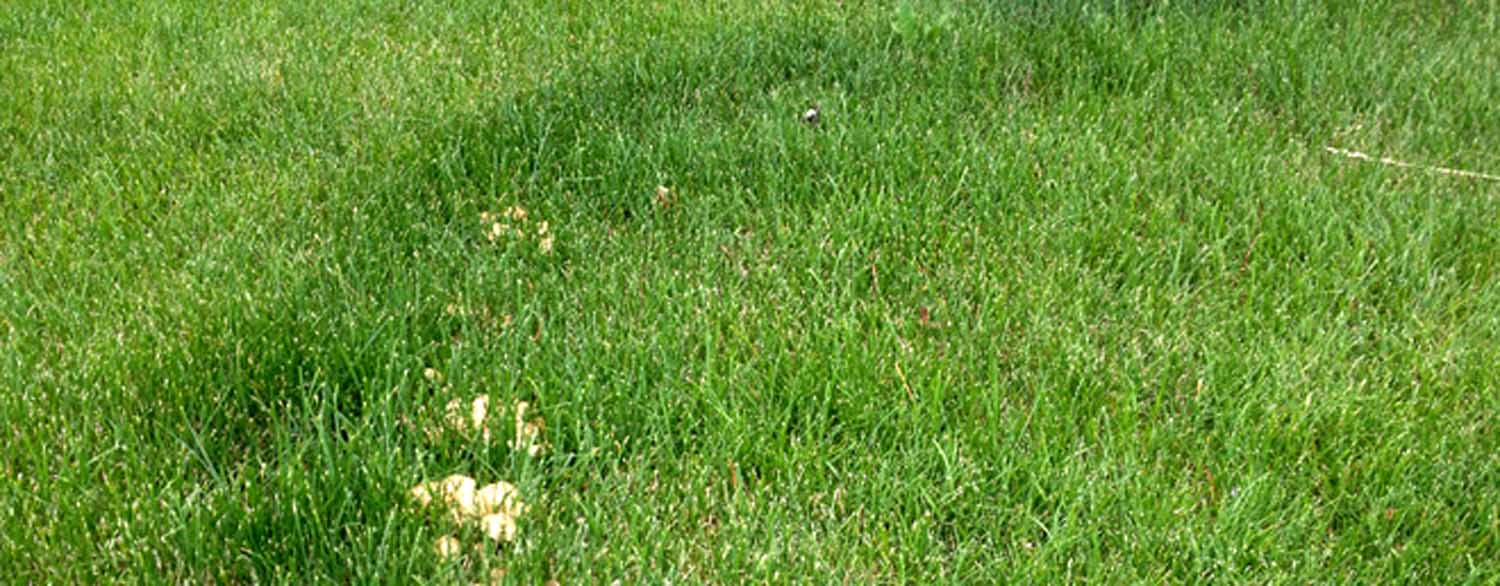Fairy Rings & Other Mushrooms
by Rob Sproule,
During wet summers people come into the greenhouse everyday asking what they can use to get rid of the mushrooms sprouting in their lawn. The good news is that most species (see below for the exception) won’t harm your grass and will disappear as moisture levels fall. The bad news is that, other than snipping off the toadstools, there’s nothing you can do.
What are they?
Think of the visible portion of a mushroom as a flower. Below it there’s a vast network of microscopic filaments, called hyphae. When hyphae binds together to form a mass of white or dark threadlike growth, it’s called a mycelium. This is what you would find beneath that humble toadstool.
Just like a plant waits for the right conditions to flower, the mycelium waits for sufficient moisture to “bloom” (send up mushrooms). In dry years, the fungus simply waits under the soil for enough rain to fall.
Fungus look small, but when filaments keep threading together they can form massive organisms. A mushroom in eastern Oregon is often described as the largest living thing on earth and covers 2,200 acres.
Controlling them.
The white mushrooms in your lawn are feeding off old thatch, buried bits of wood, and other assorted decaying matter that the mycelium is wrapping around. If you have an older lawn, annual aerating to clear out the thatch would be good start to reducing their numbers.
Surface mushrooms are fruiting and their only goal in life is to spread spores. Try to pick them before they can do this, as each of the countless spores they release into the air will become hyphae of their own and will seek to build new underground infrastructure.
When you mow your lawn, you may want to use a bag if they are widespread. Collecting the shredded fungus bits in a bag will keep them, and the developing spores, off the lawn.
There’s no chemical treatment, and the only way to make sure they’re gone is to dig them out. You’ll need to dig up the entire yard down deep enough that you can’t find any more white strands of mycelium. This is often several feet deep.
My advice is to learn to live with them, and if you’re so inclined take the opportunity to learn about fungus and the amazing role it plays in our ecosystem.
Fairy Ring
While most mushrooms that pop through your grass during wet summers are harmless, some are aggressive enough to damage your lawn. Fairy Rings have always been a sore spot for Alberta gardeners because they are highly visible and devilishly difficult to get rid of.
Fairy Ring is a mushroom species that naturally occurs in arcs. Like all mushrooms, the fungal fibers (mycelia) are mostly underground. Unlike most mushrooms, the fibers get so dense that the lawn can’t get any moisture, which creates a necrotic (dead) zone in your lawn and looks pretty darn awful.
Fairy Ring Folklore
Fairy Rings have a rich folkloric background and have been called Elf Rings, Witches Rings, and Sorcerer’s Rings in Europe. Their tendency to occur in woodland areas have linked them with supernatural stories of fairies and other elusive creatures.
Western European oral traditions are brimming with stories of fairy rings appearing as gateways between our world and the kingdoms of elves and fairies. The sprites would appear and dance within the ring, a space inhabiting both worlds, until they went back to their own world, taking the ring with them.
Keep in mind that lawns weren’t a big thing for medieval Europeans, and fairy rings usually occurred in the woods, which were ripe with their own mysteries. Folkloric stories promised that if you waited at these rings for the elves to return form their earthly mischief, you could catch them on their trip home.
William Shakespeare even wrote about Fairy Rings in his supernatural romp, “A Midsummer Night’s Dream.” When Puck asks a fairy whither it wanders, it speaks of orbs upon green:
“I do wander everywhere,
Swifter than the moon’s sphere;
And I serve the fairy queen,
To dew her orbs upon the green.” – Act II, Scene I
How to Get Rid of It
While there are a few ways to deal with it, there are no silver bullets. The first thing to do is pick the mushrooms as soon as they appear; you don’t want them to go to spore. Consider using a mowing bag if you mow over the mushrooms.
The grass above fairy ring dies of thirst because the fungus repels water away. To counter this, jab a deep-root feeder across the ring every few inches. Make sure it gets at least a foot deep.
Soak it well twice a week and you should drown out the fungus. If you don’t have a deep-root feeder a pitch-fork will suffice, although it won’t get as much water down deep.
Add a bit of dish soap to the mix at about a teaspoon/gallon concentration. The fungus doesn’t like nitrogen, so hitting the affected area with a high nitrogen fertilizer will also help.
If that sounds too labour-intensive, it’s not when compared to the option. The only other solution that I know of involves digging out the entire affected area, replacing it with fresh soil, and starting the lawn from scratch.
How deep you have to dig depends on how deep the fungus is. You’ll need to dig out all the white mycelia (you’ll know it when you see it), and even a few inches below the last visible strands.
I’ve heard digging depths of 6 inches all the way to 3-5 feet (yep… a metre). Make sure to dig 12-18 inches out from all sides of the ring, as well.
















